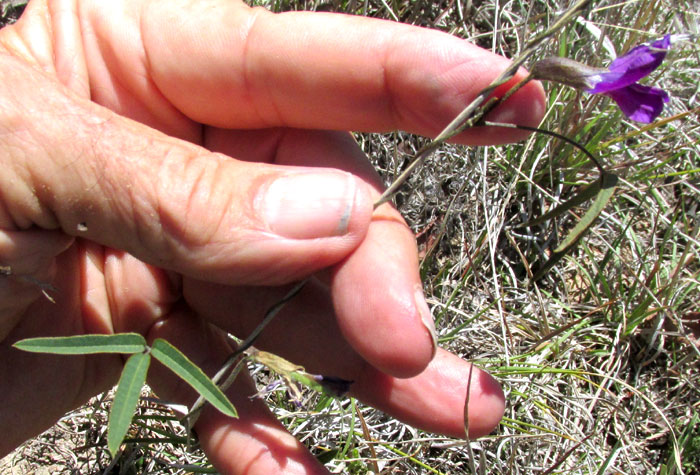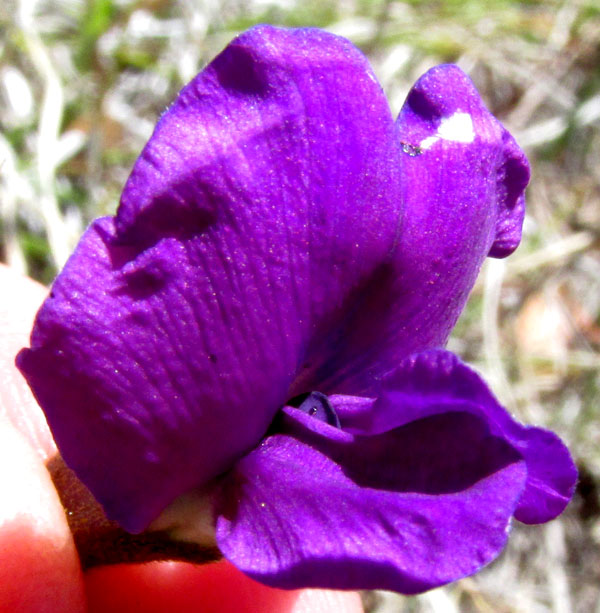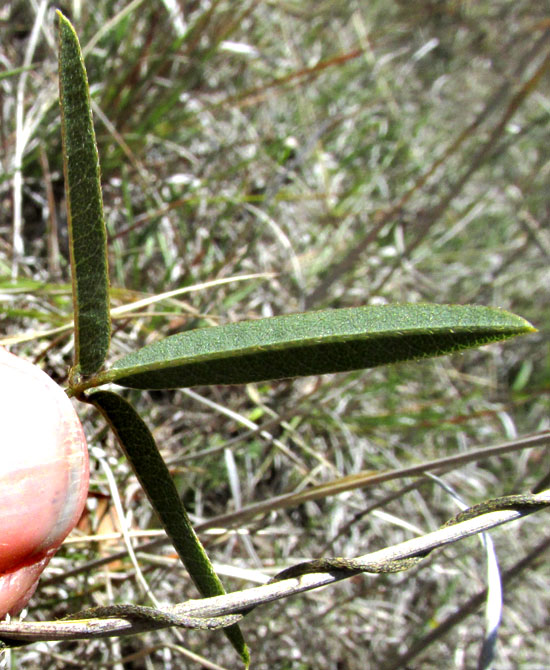Excerpts from Jim Conrad's
Naturalist Newsletter
entry from field notes dated July 2, 2022, taken on Cerro de la Cruz, at an elevation of ~2700m (~8850 ft), just south of the community of El Pinar, Amealco de Bonfil, Querétaro, MÉXICO, (~N20.17°, ~W100.17°)
LONGLEAF COLOGANIA

At the eastern base of Cerro de la Cruz a large abandoned field was covered mostly with scattered shrubs and clumpgrass. This year the rainy season hasn't come in May as it should have, so the grass is still gray/brown and crispy. Twining up the stem of one grass, the above slender vine's purple flowers stood out in the bright, highland sunlight.
Even at the above distance, the blossom's general appearance and the vine's compound leaves announce a member of the huge Bean Family, which is home to many vining species. Holding 19,000 or so species, the Bean Family is the third largest of all flowering plant families, so when you're identifying to species level, the sheer number of possibilities can be daunting.

It helps that species in the family are divided into three easy-to-distinguish subfamilies. Above, our vine's flower displays bilateral symmetry: Its right and left sides are mirror images of one another, but the top and bottom are very different. Also, the corolla is longish instead of being open showing a few fairly conspicuous, often variously shaped stamens. These features belong to the subfamily Faboideae, which is the largest-by-far of the three subfamilies, embracing about 14,000 species in some 475 genera.
To figure out which genus our plant belongs to, it helps a lot that our vine's leaf consists of three leaflets, because leaves in most genera are more subdivided. The plant being a vine helps, too. However, it's the flowers and fruits that most define the genus, and we have no fruits, so the flower's exact structure is important to notice. Above, noteworthy features of the calyx include that its top tooth is about the same length as the bottom one, and that the calyx is covered with short, stiff hairs leaning close to the body -- it's "strigose."

In the subfamily Faboideae, flowers have papilionaceous flowers, meaning that the corolla consists of a large, usually showy top petal, two side petals (the wings) and two lower petals fused along their common margin to form a scoop-shaped "keel."Above we see that our vine's top petal is unusually large relative to the other petals. It's notched at the top, almost looking like two petals. The wings twist about so that most of their surfaces lie more or less horizontally. The keel is very usual because it's so short relative to the other petals. In the picture it just peeps from the corolla's throat, while normally it's a very prominent feature.

Besides the leaves being trifoliate, the leaflets are exceptionally slender, and their margins are smooth, with no hint of teeth. The blades are somewhat stiff and leathery, and their secondary veins branch into an unusual pattern of minute reticulations. Leaflet tips bear a very short tooth, or mucro -- they're shortly mucronate.
All these details lead us to the genus Cologania, a small genus comprising only about ten species and occurring just in the Americas, from the southeastern US south to Argentina. The Flora del Bajío documents four species in our dry upland Bajío region of central Mexico. Of those four species only one is a vine with such narrow leaflets, and that's COLOGANIA ANGUSTIFOLIA.
In English Cologania angustifolia is known as the Longleaf Cologania. It's distributed from Arizona, New Mexico and Texas in the US south all the way through Mexico's uplands to Chiapas, at elevations from 1200-2500m (3900-8200 ft). It's described as common and sometimes abundant in grassy areas and clearings in forests of oak, pine and tropical deciduous forest and dry scrub.
Beyond what's given here, there's little information about this little vine. Herbivores grazing the area must gulp it down hardly noticing it.
An Interesting pollination study on a closely related species, Cologania broussonetii, also occurring in this region, found that the nectar provided by that species' flowers consisted of 62% sucrose, 24% fructose and 14% glucose. On the first day of flowering, nectar secretion continued throughout the day, but on the second day the amount of nectar offered diminished because it was reabsorbed by the plant. This was seen as an adaptation to the unpredictable visits made by just two bumblebee species. This study by Mariana Laura Musicante and Leonardo Galetto appeared in the 2008 study entitled Características del néctar de Cologania broussonetii (Balb.) DC. (Fabaceae) y su relación con los visitantes florales.